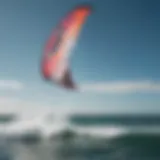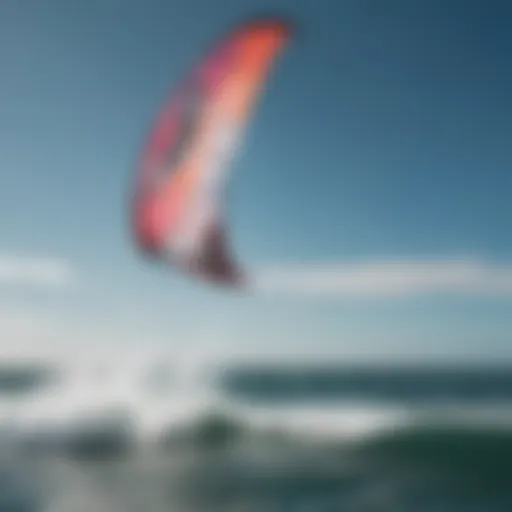In-Depth Review of Naish Kite Lines for Kitesurfing
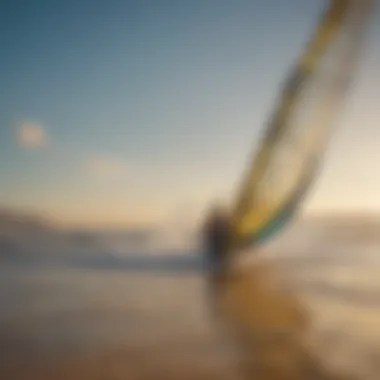

Intro
Naish kite lines are essential components in the kitesurfing experience, impacting performance, control, and safety. This article delves deeply into the various aspects of Naish kite lines. Understanding the construction and performance characteristics of these lines aids both novice and seasoned kitesurfers in making informed decisions. The examination covers types of lines, maintenance tips, and their comparisons to other brands. This comprehensive breakdown equips readers with valuable insights necessary for optimal kitesurfing performance.
Equipment Reviews
Kites: Overview of Naish Models
Naish is known for its innovative kite designs, offering models like the Naish Pivot and Naish Slash. Each kite features distinct characteristics suited for different riding styles. For instance, the Pivot is versatile, ideal for various conditions, while the Slash is oriented towards freestyle and wave riding. Naish kites come in different sizes and shapes, tailored to accommodate both beginners and advanced riders.
Kite Shapes, Sizes, and Materials
Naish kites utilize durable materials that withstand harsh weather and rapid movements. The shapes vary, with options including delta and bow kites, which cater to various wind conditions. Kite sizes are carefully designed, allowing users to select the appropriate model based on their weight and the type of kitesurfing they prefer.
Boards
The Naish brand offers a range of kiteboarding boards to suit diverse styles, including directional boards and twintips. Directional boards are usually better for wave riding, while twintips cater to freestyle and general riding.
Design and Construction
Naish boards emphasize lightweight materials for increased performance and easier handling. The boards sport features such as rocker profiles and varying widths, enhancing their capability for speed and maneuverability. This thoughtful engineering reinforces the overall kitesurfing experience.
Accessories
Accessories play a crucial role in kitesurfing. Naish provides a variety of essential accessories such as harnesses, pumps, and safety gear.
Importance of Each Accessory
- Harnesses: Essential for rider connection to the kite, providing comfort and control.
- Pumps: Important for inflating kites quickly and efficiently.
- Safety Gear: Keeps riders protected, especially in challenging conditions. Regular checks are vital.
Travel Destinations
Popular Spots
Kitesurfing is enjoyed in many beautiful locations worldwide. Places like Tarifa in Spain and Cabarete in the Dominican Republic offer reliable winds and excellent water conditions.
Off the Beaten Path
Consider exploring lesser-known kitesurfing spots that offer unique experiences. Locations like Lancelin in Australia can provide exciting waves without heavy crowds.
Techniques and Tutorials
Beginner Guides
Learning the basics of kitesurfing is vital for safety and enjoyment. Tutorials should cover fundamental skills like launching, riding, and landing.
Advanced Skills
For experienced riders, mastering advanced techniques such as jumps and wave riding can elevate the overall kitesurfing experience.
Safety Guidelines
Weather Conditions
An awareness of weather patterns and conditions is crucial for safe kitesurfing. Understanding wind speeds and water currents helps maintain personal safety and equipment integrity.
Emergency Protocols
In the event of an emergency, knowing essential rescue tactics could prove invaluable. Familiarize yourself with techniques and procedures to handle mishaps effectively.
Equipment Maintenance
Regular equipment checks are necessary to ensure functionality and safety. This includes inspecting lines, kites, boards, and safety gear for wear and tear.
Proper maintenance extends the life of your gear and significantly improves performance.
Prelims to Naish Kite Lines
Naish kite lines play a crucial role in the world of kitesurfing. They connect the rider to the kite and influence how well the kite responds to inputs. This section delves into the significance of these lines. A solid understanding of Naish kite lines provides both novice and seasoned kitesurfers with essential insights into performance and safety.
Performance Impact
Kite lines influence various performance metrics such as control, speed, and stability. The design and materials of Naish lines are tailored to enhance these factors. Riders experience direct feedback through the lines, making them an integral element in the kitesurfing experience.
Construction Quality
Naish is known for prioritizing high-quality materials and construction techniques. This focus ensures durability and reliability, which are vital during extreme conditions. Understanding the composition and build gives kitesurfers confidence in their equipment, leading to better decision-making in gear selection.
Variety and Customization
Naish offers a range of kite lines tailored to different styles and conditions. By understanding these options, users can select lines that best fit their individual needs and preferences. A comprehensive knowledge about these lines helps in optimizing setups for different types of conditions.
This introduction sets the stage for an in-depth examination of Naish kite lines. Each aspect, from composition to maintenance, will be discussed to prepare kitesurfers for informed choices. It is not just about selecting lines; it is about enhancing the overall kitesurfing experience for maximum enjoyment and safety.
Composition of Kite Lines
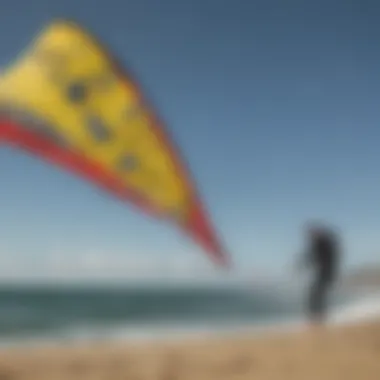

The composition of kite lines plays a crucial role in the performance and durability of kitesurfing gear. Understanding the materials and construction techniques involved is essential for any kitesurfer who wants to optimize their setup. Kite lines need to be robust, yet lightweight, allowing them to manage the considerable forces exerted during kitesurfing.
Materials Used in Naish Kite Lines
Dyneema Fiber
Dyneema fiber is one of the primary materials used in Naish kite lines. Its strength-to-weight ratio is exceptionally high, making it a preferred choice for kitesurfers demanding durability. Dyneema is known for its low stretch characteristics, which ensures that kites remain responsive and maintain control in varied conditions. This quality is significant as it enhances performance, especially when executing high jumps or sharp turns.
Another unique feature of Dyneema is its resistance to UV radiation and abrasion. This aspect is critical as it extends the lifespan of the lines when exposed to sunlight and harsh environments. However, it is worth noting that Dyneema can be more expensive than other materials, which might be a consideration for budget-conscious riders.
Polyester Components
Polyester components also find importance in Naish kite lines. Polyester is known for its affordability and decent tensile strength. While not as strong as Dyneema, polyester has its merits. It possesses a higher degree of elasticity, which can help absorb shock loads during intense use. This feature makes polyester an ideal choice for beginners who may experience sudden changes in tension.
One of the defining characteristics of polyester is its resistance to environmental factors. It does well against mildew and moisture. Nonetheless, it may not perform as well under extreme conditions, leading some advanced riders to prefer specialized materials like Dyneema.
Construction Techniques
Braided vs. Non-Braided
Kite lines can be constructed using either braided or non-braided techniques. Braided lines provide superior strength and flexibility. The braided structure allows for improved load distribution, which contributes to less wear over time. This method is often recommended for experienced kitesurfers looking for optimal performance. The flexibility in braided lines helps in enhancing tension control, especially when under immense strain.
On the other hand, non-braided lines are often easier to manufacture and can be more budget-friendly. However, they may lack the same level of strength and responsiveness as their braided counterparts. Riders should carefully consider their style and skill level when choosing between these options.
Load Distribution Design
Load distribution design is another fundamental aspect of kite line construction. This design technique focuses on evenly distributing forces throughout the line during use. Improved load distribution reduces the risk of failure and enhances overall line longevity. Naish kite lines are engineered to handle high load situations effectively, which is crucial during high-performance maneuvers.
A well-designed load distribution boosts the kinetic energy transfer from the rider to the kite. This not only improves performance but also contributes to a safer riding experience. However, lines with more complex load distribution might require more care in regular maintenance, adding a consideration for dedicated kitesurfers.
"To make an informed choice, consider your kitesurfing style, the conditions you often face, and how each material and technique may influence your performance."
Types of Naish Kite Lines
The selection of kite lines directly impacts the performance, handling, and overall experience of kitesurfing. Understanding the different types of Naish kite lines allows riders to make informed choices that align with their personal preferences and kitesurfing styles. This section will explore the various types, highlighting their specific characteristics, benefits, and typical use cases.
Standard Lines
Characteristics of Standard Lines
Standard lines are the baseline option for kitesurfers, known for their balanced performance and durability. These lines often feature a good tensile strength suitable for various riding conditions. The key characteristic of standard lines is their reliability. They are designed to withstand the rigors of everyday kitesurfing, making them a popular choice for both novices and experienced riders.
A unique aspect of standard lines is their adaptability across multiple kite setups. This characteristic allows riders to switch between different kite configurations without needing to replace the lines. However, while standard lines offer convenience and ease, they may not provide the specialized performance found in higher-end options.
Typical Uses in Kitesurfing
Standard lines find their place in recreational kitesurfing, typically catering to riders new to the sport. These lines work well in average wind conditions, making them suitable for regular practice. Their key feature is versatility, as standard lines can be used for both freestyle and cruising styles of riding.
A notable advantage is cost-effectiveness. Riders opting for standard lines can save on initial expenses while still achieving satisfactory performance. However, some riders seeking advanced features might find standard lines slightly limiting in specific high-performance scenarios.
Performance Lines
Benefits of Using Performance Lines
Performance lines are engineered for kitesurfers looking to maximize their experience in technical riding. They provide enhanced responsiveness and control, making them ideal for maneuverability at high speeds. The key benefit of these lines is their superior materials, often comprising lighter fibers that reduce drag. This feature leads to improved speed and agility.
Another crucial element is stability. Performance lines exhibit less stretch, translating to better power delivery from the kite. However, the trade-off might be in the way these lines handle under extreme conditions, where they can be less forgiving than standard lines.
Optimal Conditions for Performance Lines
Performance lines shine brightest in advanced riding scenarios, particularly in high wind conditions. Ideal situations include competitive settings or riders pursuing tricks that require quick response times. The key feature here is precision, which benefits technical riders needing exact control over their kite movements.
However, it’s important to note that performance lines may not be the best choice in moderate wind or for beginners. They often perform best when the rider's skill level is high and requires a more nuanced understanding of kite dynamics.
Custom Lines
Tailoring Lines for Specific Needs
Customization of kite lines allows riders to create lines that fit their personal style and preferences. Tailoring lines for specific needs can involve varying lengths, thicknesses, and even materials used in construction. A standout feature is the ability to match line characteristics to unique riding styles. This adaptation can enhance performance significantly, offering benefits that standard or performance lines cannot.
Many riders find value in this empowerment, as it provides an opportunity to optimize their kites for trick performance, speed, or stability. Nevertheless, customizing lines can also lead to complications. Riders must consider the implications of their choices carefully, as a poorly chosen configuration may hinder performance instead of improving it.
Considerations for Customization
When considering customization, kitesurfers should evaluate their personal skill level and riding conditions. Important features to consider include line length and the desired stiffness of the lines. These specifics can make a difference in how fast or responsive the kite becomes.
Additionally, a thorough understanding of the kite's characteristics is essential for effective customization. While custom lines offer significant advantages, they can also introduce variability that might not suit everyone's needs or riding style. Furthermore, potential costs associated with customizing can be a consideration for those on a budget.
Custom lines provide a unique opportunity for personalization, aligning kite characteristics with rider preferences for optimal performance.
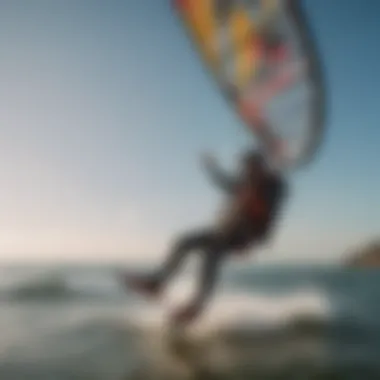

Performance Characteristics of Naish Kite Lines
Understanding the performance characteristics of Naish kite lines is essential for any kitesurfer. This section delves into the key factors that define the functionality and overall effectiveness of these lines. Better performance is synonymous with enhanced control, buoyancy, and stability, all of which are critical in various riding conditions.
Tensile Strength
Comparative Metrics
Tensile strength measures how much force a material can withstand without breaking. In the context of Naish kite lines, this metric is pivotal. Strong lines contribute to the safety and reliability of the kitesurfing experience. The comparative analysis of different materials used in kite lines reveals that Naish often utilizes specifications far above industry standards.
Lines made from Dyneema fiber, for example, are known for their exceptional strength-to-weight ratio. This key characteristic makes them an excellent choice for kitesurfers looking for durable and lightweight options. Additionally, the unique resistance to UV degradation in these lines ensures longevity and consistent performance, which benefits kitesurfers by reducing the frequency of line replacements.
Real-World Performance Insights
Real-world performance insights focus on how kite lines behave under actual riding conditions. Naish kite lines have received favorable reviews for their ability to maintain integrity during extreme maneuvers. This real-world applicability is crucial for kitesurfers who often push their limits.
The ability of these lines to retain their tensile strength even after extended use highlights the advantages of investing in quality equipment. It is noted that kitesurfers using Naish lines report confidence in their gear, even in turbulent conditions. This type of performance assurance is attractive for athletes who seek reliability as they challenge themselves in diverse environments.
Flexibility and Responsiveness
Impact on Maneuverability
Flexibility and responsiveness are two attributes that greatly influence maneuverability. Kite lines that offer excellent flexibility allow for more dynamic movements. This aspect is particularly advantageous for kitesurfers aiming for tricks and rapid directional changes. Naish kite lines are designed to provide optimal flexibility without compromising strength, enabling riders to execute maneuvers seamlessly.
The immediate responsiveness of these lines is another remarkable feature. Kitesurfers experience an almost instantaneous reaction to steering inputs. This responsiveness contributes to an improved overall experience, as it allows for precise control during various tricks and jumps.
Handling during Various Conditions
The handling of kite lines during various conditions is a further consideration for performance. Naish kite lines have been observed to perform well in both smooth and choppy water. This versatility means that whether navigating small waves or larger swells, these lines adapt effectively to the changing environment.
A noteworthy characteristic of Naish kite lines is their stable handling, regardless of wind conditions. This trait is valuable for kitesurfers who wish to focus on skill rather than equipment performance issues. Such stability enhances both confidence and enjoyment on the water. However, it is worth mentioning that varying lengths can affect performance, which kitesurfers must consider while making their choice.
"Quality kite lines can make a significant difference in every kitesurfing session, from casual rides to intense challenges."
By examining tensile strength and flexibility, alongside responsiveness, it becomes clear how Naish kite lines stand out in performance. These characteristics equip kitesurfers with the tools needed to thrive in diverse conditions.
Maintenance and Care of Naish Kite Lines
Proper maintenance and care of Naish kite lines are essential for ensuring safety and optimizing performance in kitesurfing. The lines play a crucial role in connecting the kite to the rider, and any neglect can lead to serious issues during use. Regular inspection and upkeep directly impact the longevity and reliability of the lines. This section discusses critical inspection practices, cleaning recommendations, and the importance of these routines for both novice and experienced riders.
Regular Inspection Practices
Identifying Wear and Tear
Identifying wear and tear on kite lines involves examining them for fraying, cuts, or any other signs of degradation. Regular checks help maintain performance and safety. A key characteristic of this practice is its proactive nature. By consistently monitoring the lines, users can catch potential issues before they escalate. This attentiveness often leads to better performance and a safer experience on the water.
The unique feature of identifying wear and tear lies in its straightforward approach. It doesn’t require advanced tools or expertise, just a keen eye and a commitment to safety. When a rider routinely inspects their lines, they can avoid dangerous situations that may arise from equipment failure. The advantage of this practice is higher confidence in the gear that one is using. However, neglecting it can result in catastrophic outcomes, making it a highly beneficial procedure.
Timeliness of Replacements
Timeliness of replacements refers to the need to change out lines before they become too worn. This proactive approach can drastically reduce the risk of accidents. A critical characteristic is that timely replacements provide peace of mind when riding in diverse conditions. Knowing that lines are fresh is crucial for performance-oriented riders, and this makes it a popular choice among kitesurfers.
The unique aspect of timely replacements is that they facilitate thinking ahead. By adhering to a replacement schedule—especially after extensive use—riders ensure that they are always prepared for the next session. The advantage here is in maintaining optimal performance, while the downside of delayed action can result in unexpected breakages, impacting not just performance but also safety in more challenging environments.
Cleaning Recommendations
Best Products for Line Care
Selecting the best products for line care plays a vital role in maintaining the durability and functionality of Naish kite lines. Options tailored specifically for these applications are available in the market, including gentle soaps and protective sprays. These products are a critical aspect of line maintenance, as they contribute to the overall longevity of the gear. Their effectiveness and user-friendliness make them a valuable choice based on their unique ability to keep lines clean without risking damage.
Using appropriate products ensures that the lines can resist dirt and saltwater buildup. This keeps the lines functioning smoothly and looking good. Moreover, having easy-to-use products encourages regular cleaning habits, reinforcing the benefits of routine maintenance in kitesurfing. However, using harsh chemicals can degrade the materials of the lines, stressing the need to choose wisely.
Implications of Poor Maintenance
The implications of poor maintenance can be far-reaching. Lines that are not regularly inspected or cleaned can lead to a gradual decline in performance and safety. A critical characteristic of this downside is that it often goes unnoticed until a failure occurs. This unforeseen nature makes it a significant concern for kitesurfers who prioritize both performance and safety.
Failing to maintain kite lines can also result in costly repairs or replacements. Regular inspections and cleaning can catch issues early, avoiding bigger problems in the long run. The unique feature here is that the consequences affect not only the equipment but also the rider’s confidence and enjoyment on the water. Poorly maintained lines can lead to accidents, creating a compelling case for why maintenance should never be overlooked.
"Investing time in maintenance is investing in safety and performance."
This section reinforces the importance of maintenance and care for Naish kite lines. With regular inspection practices, the risk of wear and potential accidents diminishes significantly, ensuring optimal experiences for kitesurfers at all skill levels. Following sound cleaning recommendations further enhances the lifespan of the lines, while recognition of the implications of poor maintenance helps riders make informed decisions about their gear.
Comparative Analysis with Other Brands
A comparative analysis with other brands provides valuable insights into the distinct characteristics and performance of Naish kite lines. This examination is crucial for both new and experienced kitesurfers, as it allows them to understand how Naish's offerings measure up against the competition. Several elements are important here, including durability, user experiences, cost considerations, and performance gaps. By evaluating these factors, enthusiasts can make informed choices that align with their specific needs.
Advantages Over Competitors
Durability Comparisons
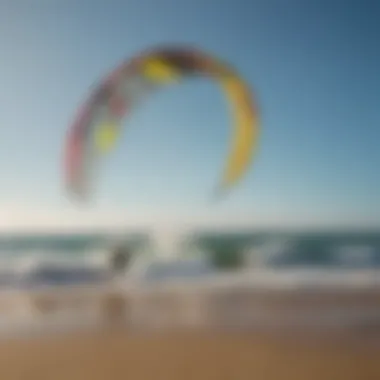

Durability is a key aspect of kite lines that significantly affects a kitesurfer's experience. Naish kite lines are known for their ability to withstand harsh conditions. They often incorporate high-quality materials, which contribute to better longevity. Compared to other brands, Naish lines typically show less wear and tear, even after repetitive use. This characteristic makes them a reliable choice for those wanting to minimize the frequency of line replacements.
Furthermore, the unique construction techniques utilized in Naish lines lead to superior resilience. This means that a kitesurfer can focus more on their performance rather than being worried about line integrity. Such durability results in fewer safety concerns and enhanced confidence while riding.
"Durability in kite lines prevents unnecessary risks and ensures kitesurfers enjoy their sessions without worries."
User Experience Analysis
User experience is another crucial element in assessing kite lines. Naish kite lines are frequently praised for their performance characteristics, including responsiveness and flexibility during various maneuvers. Kitesurfers frequently report a feeling of ease while controlling their kites, resulting in a positive overall experience.
One unique feature of Naish lines is their user-oriented design. This attention to detail ensures that they cater to a wide range of skill levels. Instead of a one-size-fits-all approach, Naish gives options that resonate with various riding styles. This adaptability enhances user satisfaction but may also require a learning curve for some, especially when shifting from other brands.
Limitations
Despite their strengths, Naish kite lines do have limitations that should be considered in a comparative analysis. Being aware of these can lead to more balanced decision-making.
Cost Considerations
Cost is a significant factor for many kitesurfers considering their gear. Naish typically positions its products at a higher price point compared to some competitors. While the durability and user experience provide substantial benefits, the upfront investment can deter some potential buyers. However, for serious riders, the longevity may justify the expense, making them a cost-effective choice in the long run.
The higher initial cost should be weighed against performance metrics and the need for replacements in budget options, which could lead to greater overall expenses.
Performance Gaps
While Naish kite lines deliver excellent performance in various conditions, they may not excel in every scenario. For specific conditions or extreme sports needs, competitors might offer specialty lines that perform better under certain circumstances. For example, some other brands may focus more on lightweight materials that cater specifically to freestyle riders, which can appeal to that niche.
Considering these performance gaps allows kitesurfers to match their line choice to their specific requirements. It’s essential to evaluate personal priorities, whether they emphasize adaptability, durability, or specialized conditions.
Choosing the Right Naish Kite Lines for Your Needs
Selecting the appropriate kite lines is essential for kitesurfing performance and safety. Naish kite lines come in various types, each tailored to specific riding styles and environmental conditions. Therefore, understanding the nuances of your needs leads to informed decisions that can enhance your overall experience on the water.
In this section, we will delve into how to assess your kitesurfing style and the significance of line length options. Both aspects are vital in ensuring that you maximize not only the performance of the kite but also your own skills and enjoyment.
Assessing Your Kitesurfing Style
Riding Conditions
Riding conditions refer to the environmental factors like wind strength, water conditions, and the rider’s geographical location. It is crucial to consider these factors when selecting Naish kite lines. For instance, in high-wind areas, thicker lines made from materials like Dyneema ensure durability and enhanced safety. On the other hand, lighter lines may suffice in lighter wind conditions.
What makes this aspect particularly valuable is how it directly affects your performance. If you often ride in choppy water or turbulent winds, investing in lines that can withstand rigors is recommended. They help improve control and stability, which is especially critical in dynamic riding conditions.
In contrast, using lines not suited for your riding conditions can lead to decreased performance or even breakage. Thus, it is important to understand the relationship between your environment and the kite lines.
Skill Level Adaptations
Skill level adaptations involve adjusting line choices based on the rider’s experience and proficiency in kitesurfing. For beginners, a thicker line may provide added durability, while a skilled rider might prefer a thinner, performance-oriented line for responsiveness and agility.
Beginners also benefit from using more forgiving lines. These lines can help reduce the chances of accidents, making it a safer option for those still mastering the fundamentals of kitesurfing. Conversely, advanced riders typically seek a more direct connection with their kite, which demands a different line structure and design.
This aspect is valuable as it underscores the importance of matching line specifications with a rider’s abilities. Choosing lines that cater to one’s skill level can greatly enhance the learning curve and promote long-term safety.
Line Length Options
Standard Length Adaptability
Standard length adaptability refers to the flexibility in choosing line lengths that suit various kitesurfing needs. Standard lengths often cater to the majority of riders, giving them versatility for different conditions and styles. This adaptability makes it easier for individuals to transition between different types of riding.
One of the key characteristics of standard line lengths is how they can serve both beginner and advanced riders alike. Beginners can utilize standard lengths without needing extensive adjustments or customizations. On the other hand, seasoned riders may have their preferences but still appreciate the standard options as a fallback for various conditions.
This adaptability is beneficial as it can simplify the selection process. If standard lengths can support diverse riding styles, it allows riders more freedom to experiment with their kites without worrying about drastic adjustments.
Impact of Length on Performance
The impact of line length on performance is an important consideration for kitesurfers. Line length can influence aspects such as speed, lift, and control. Shorter lines often provide quicker reactions and tighter turning radius, favorable for tricks and aerial maneuvers.
However, longer lines usually yield increased power and stability in low-wind conditions. It is crucial to highlight how choosing the correct length can lead to optimal performance in various wind conditions. Riders may find that switching between lengths based on the current environment can lead to improved results.
An understanding of the impact of line length on performance provides valuable insight into achieving the desired riding experience. Whether aiming for fast loops or stable cruising, adapting line length accordingly can be the key to unlocking one's full potential on the water.
Choosing the right Naish kite lines is not just about preference; it directly correlates with performance, safety, and enjoyment on the water.
The End
In this article, we have examined the many facets of Naish kite lines, emphasizing their crucial role in the realm of kitesurfing. The conclusion serves not only as a summary but also as a pivotal element that reinforces the significance of informed decision-making when selecting kite lines.
Understanding the various construction techniques utilized in Naish kite lines highlights their durability and adaptability to different conditions. Performance lines, with their unique advantages, cater to individuals looking for that competitive edge. Conversely, custom lines present opportunities for personalization, allowing riders to tailor their equipment to their specific needs. This adaptability is essential, as each kitesurfer has distinct preferences dictated by style, conditions, and skill level.
Key Considerations
- Line Material: The superb use of materials like Dyneema fiber ensures that the kite lines are lightweight yet incredibly strong.
- Maintenance Practices: The importance of regular inspection and cleaning cannot be overstated. Neglecting these aspects can lead to performance declines and increased safety risks.
- Cost-Benefit Analysis: While Naish kite lines may come with a premium price tag, their long-term performance often justifies the investment through enhanced durability and user satisfaction.
The insights gathered from comparing Naish kite lines with competitors provide a comprehensive view of where they excel and where they may be lacking. This becomes valuable for both novice and seasoned riders who strive to enhance their experience on the water.
"Choosing the right kite line is as critical as selecting the right kite itself. It affects everything from maneuverability to overall enjoyment while kitesurfing."
Ultimately, this article aims to equip readers with essential knowledge, enabling them to make educated choices about their kite lines. Properly understanding Naish kite lines ensures that every kitesurfer can maximize their performance and safety on the water.
